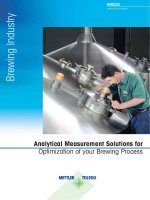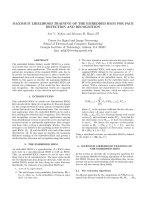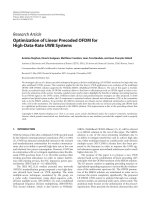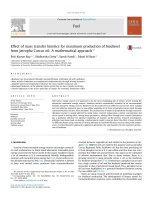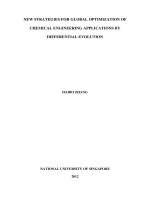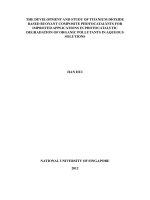Optimization of laminated composite plates for maximum biaxial buckling load
Bạn đang xem bản rút gọn của tài liệu. Xem và tải ngay bản đầy đủ của tài liệu tại đây (949.58 KB, 12 trang )
VNU Journal of Science: Mathematics – Physics, Vol. 36, No. 2 (2020) 1-12
Original Article
Optimization of Laminated Composite Plates
for Maximum Biaxial Buckling Load
Pham Dinh Nguyen1, Quang-Viet Vu2, George Papazafeiropoulos3,
Hoang Thị Thiem1, Pham Minh Vuong1, Nguyen Dinh Duc1,*
1
Advanced Materials and Structures Laboratory, VNU University of Engineering and Technology,
Vietnam National University, Hanoi, 144 Xuan Thuy, Cau Giay, Hanoi, Vietnam
2
Faculty of Civil Engineering, Vietnam Maritime University, 484 Lach Tray, Hai Phong, Vietnam
3
Department of Structural Engineering, National Technical University of Athens,
Zografou, Athens 15780, Greece
Received 11 April 2020; Accepted 05 May 2020
Abstract: This paper proposes an optimization procedure for maximization of the biaxial buckling
load of laminated composite plates using the gradient-based interior-point optimization algorithm.
The fiber orientation angle and the thickness of each lamina are considered as continuous design
variables of the problem. The effect of the number of layers, fiber orientation angles, thickness and
length to thickness ratios on the buckling load of the laminated composite plates under biaxial
compression is investigated. The effectiveness of the optimization procedure in this study is
compared with previous works.
Keywords: Optimum design, Fiber angles, Biaxial compression, Laminated composite plates,
Abaqus2Matlab.
1. Introduction
Composite materials are widely applied in many heavy duty engineering structures. Composite
materials are lightweight and they have low density, high strength and high stiffness. Those properties
are a results of the characteristics of the main constituents of composite materials. Therefore, the optimal
design of the latter depends on the design of their various components. Optimization problems involving
________
Corresponding author.
Email address:
https//doi.org/ 10.25073/2588-1124/vnumap.4509
1
2
P.D. Nguyen et al. / VNU Journal of Science: Mathematics – Physics, Vol. 36, No. 2 (2020) 1-12
laminated composite plates are often sophisticated because of the numerous design variables and their
complex behavior which depends on the properties of the laminae.
In recent years, many studies have been published for the buckling analysis of the laminated
composite structures subjected to various loads. The analysis of composite plates using finite element
methods (FEMs) has been reported by applying the first-order shear deformation theory (FSDT), Wang
et al. [1] presented the results of natural frequencies and buckling load of the laminated composite plates,
Ferreira et al. [2] shown the critical buckling load of isotropic and laminated plates, Nguyen-Van et al.
[3] presented the free vibration and buckling analysis of composite plates and shells using a smoothed
quadrilateral flat element, Thai et al. [4] studied the static, free vibration, and buckling analysis of
laminated composite plates with quadratic, cubic, and quartic elements. By using the higher-order shear
deformation theories (HSDT), the results of critical buckling load and natural frequencies of cross-ply
laminated plates had been reported by Khdeir and Librescu [5] and Faces and Zenkour [6], Chakrabarti
and Sheikh [7] investigated the buckling analysis of laminated composite plates using a triangular
element. The buckling analysis of composite structures using an analytical method has been reported by
Duc et al. [8, 9] using the FSDT for the composite plates resting on elastic foundations, Le et al. [10]
presented the nonlinear buckling analysis of functionally graded graphene-reinforced composite
laminated cylindrical shells under axial compressive load. The buckling analysis of composite plates
and shells using a semi-analytical method has been reported by Kermanidis and Labeas [11] and
Mohammad and Arabi [12].
The optimum design is a significant problem in structural engineering which is intended to increase
the performance of structures. The optimum values of fiber angles for maximizing the buckling load of
the laminated composite plates has been investigated in [13, 14] where the plate had been subjected to
uniaxial compression [13], bending load and both [14] under various boundary conditions. Studies for
the optimal design of the stacking sequence have been carried out by Riche and Haftka [15] using a
genetic algorithm, Jing et al. [16] using a permutation search algorithm and Almeida [17] using a
harmony search algorithm, Bargh and Sadr [18] using a the particle swarm optimization algorithm. Both
fiber angles and thickness are used as design variables to obtain the maximum buckling load in the
studies by Huang and Kroplin [19] using a variable metric algorithm, Akbulut and Sonmez [20] using
the simulated annealing algorithm, Ho-Huu et al. [21] using an improved differential evolution
algorithm. Chandrasekhar et al. [22] studied the topology optimization of laminated composite plates
and shells using optimality criteria.
From the above literature review, this paper proposes a new optimization procedure for the
laminated composite plates subjected to biaxial compression to obtain maximizing buckling load with
design variables are fiber angles and thickness. The optimization procedure is implemented by using
Abaqus2Matlab [23] which is designed for transferring model and/or results data from Abaqus to Matlab
and vice versa to generate the necessary Abaqus input files, run the analysis and extract the analysis
results in Matlab.
2. Methodology
2.1. Buckling Analysis of Laminated Composite Plates
Consider a laminated composite plate that is subjected to biaxial compression, as shown in Figure
1. The composite plate consists of n laminae, each one having its own fiber angle and thickness. The
total thickness, length and width of the plate are h, a, b , respectively.
P.D. Nguyen et al. / VNU Journal of Science: Mathematics – Physics, Vol. 36, No. 2 (2020) 1-12
a.
Coss-section of lamina.
b.
3
Layers of the plate.
Fig. 1. Model of the composite laminated plate subjected to biaxial load.
In the buckling analysis, the eigenvalues ( i ) and buckling mode shapes ( i ) are obtained by
solving the eigenvalue problem:
K
i
i
0
(1)
in which, K , are the stiffness and stress matrices, respectively.
The critical eigenvalue buckling analysis ( the first eigenvalue cr ) is used to determine the critical
buckling load ( Fcr ) with N is the applied load as follows:
Fcr cr N
(2)
The buckling coefficient of the laminated composite plates is determined by:
k
cr a 2
E2 h3
(3)
2.2. Optimization Method
2.2.1. Statement of the Problem
The objective of the optimization problem is to maximize the biaxial buckling load factor of the
composite plate. The design variables of the optimization problem are the fiber angles and the
thicknesses of the laminae of the composite plate, which are continuous variables. The optimization
problem contains an equality constraint, stating that the sum of the laminae thicknesses be equal to the
total thickness of the plate.
The optimization problem is mathematically described as:
Maximize:
(4)
cr ti ,i
n
Subject to
t
i 1
i
h, tlb ti tub , lb i ub , i 1 n ,
in which, ti is the ith lamina thickness which varies from lower bound tlb to upper bound tub , i is
the fiber angle of the ith lamina which varies from lb 900 to ub 900 .
4
P.D. Nguyen et al. / VNU Journal of Science: Mathematics – Physics, Vol. 36, No. 2 (2020) 1-12
2.2.2. Proposed Optimization Procedure
This section presents an optimization procedure using the gradient-based interior point algorithm
(IPA) to calculate the optimum fiber angles and thickness of the laminated composite plates. This
optimization procedure integrates Matlab and Abaqus in a loop with the use of Abaqus2Matlab, which
is developed by Papazafeiropoulos et al. [23]. All steps of this optimization process are described in
Figure 2.
Construct a Matlab function
which automatically creates an
input file for Abaqus(*inp)
Define design variables (Fiber
angles and thickness:
)
Define the objective function
(Buckling load factor )
Pre-processes
Construct the main code
Assign an initial value for the
design variables. Run analysis
for the first time
Calculate
functions
the
objective
Optimization using nonlinear
programming solver with the IPA
Meeting
termination
criteria
YE
S
Optimization results
Run the Abaqus analysis
A2
M
N
O
Create new Abaqus text
file
Main
loop
Finish
Fig. 2. Flowchart of the optimization procedure.
P.D. Nguyen et al. / VNU Journal of Science: Mathematics – Physics, Vol. 36, No. 2 (2020) 1-12
5
3. Numerical Results and Discussions
3.1. Validation
In this section, the buckling coefficient k
cr a 2
of the laminated composite plates under uniaxial
E2 h3
and biaxial compression are compared with previous works. The material properties of the laminated
composite plates is given as follows: E1 / E2 40, G12 G13 0.6E2 , G23 0.5E2 , v12 0.25 ,
a b 1, a / h 10. Tables 1 and 2 compare the buckling load factors of the laminated composite plates
(16x16 elements) to verify the Abaqus model developed in this study. Tables 3 and 4 present the
comparison results of the optimization of fiber angles and thickness of the laminated composite plates
(12x12 elements) when the number of layers is 3, 4, and 10.
From the comparison, it can be shown that the developed model in this paper is reliable to use for
the analysis of the laminated composite plates. The last column of Tables 3 and 4 contains the number
of structural analyses (NSA) required to reach the optimum solution
Table 1. Comparison of the buckling load factors of [0/90] 5 laminated plates under uniaxial compression
SSSS
SSCC
SSSC
SSFC
SSFS
SSFF
Wang et al. [1]
25.703
35.162
32.95
14.495
12.658
12.224
Nguyen et al. [3]
25.534
34.531
32.874
14.356
12.543
12.131
Thai et al. [4]
25.5269
35.1784
32.6882
14.4828
12.6174
12.2338
Ho-Huu et al. [21]
25.2562
35.0937
32.7586
14.3433
12.4929
-
Present study
25.2411
34.0573
31.955
14.2248
12.4172
11.992
Table 2. Comparison of the buckling load factors of SSSS [0/90/0] square plates under biaxial compression
E1 / E2
10
20
30
40
Nguyen et al. [3]
Thai et al. [4]
Khdeir and Librescu [5]
Fares and Zenkour [6]
Present study
4.939
4.9958
4.963
4.963
4.9461
7.488
7.5155
7.516
7.588
7.458
9.016
8.8712
9.056
8.575
8.6595
10.252
10.0525
10.259
10.202
9.6655
Table 3. Comparison of the optimum ply-angle of SSSS square composite plates under biaxial compression
Ho-Huu et al. [21]
No of layers
[i o ]
k
NSA
3 [1 / 2 /3 ]
[0/90/0]
[45/-45/-45]
[0/90/0]
[45/-45/45]
10.23938
12.37798
9.7377
11.232
11.68617
1
960
1
99
1
15.66063
520
11.634
1
14.871
68
Present study
Ho-Huu et al. [21]
Present study
4
[1 / 2 ]s
[0 / 90]s
[ 45 / 45]s
[0 / 90]s
[ 45 / 45]s
6
P.D. Nguyen et al. / VNU Journal of Science: Mathematics – Physics, Vol. 36, No. 2 (2020) 1-12
Ho-Huu et al. [21]
10
[1 / 2 /3 /4 / 5 ]s
Present study
[0 / 90]5
[45/-45/-45/-45/45]s
[0 / 90]5
[45/-45/-45/-45/45]s
12.71699
1
19.50038
1040
12.671
1
19.524
242
a.
SSSS
b.
SSCC
c.
SSSC
d.
SSFC
e.
SSFS
f.
SSFF
Fig. 3. Buckling modes of laminated plates with various boundary conditions.
P.D. Nguyen et al. / VNU Journal of Science: Mathematics – Physics, Vol. 36, No. 2 (2020) 1-12
7
Table 4. Comparison the optimum ply-angle and thickness
of SSSS square composite plates under bixial compression
[i0 ; ti 103 ]
No of layers
Ho-Huu et al.
[21]
3
Present study
[t1 / t2 /t3 ]
Ho-Huu et al.
[21]
4
Present study
[t1 / t2 ]s
[45/-45/45]
[10.213/79.539/10.247]
[45/-45/45]
[9.5996/80.8009/9.5996]
[1 / 2 /3 ]
[45 / 45]s
[1 / 2 ]s
k
NSA
19.49077
2180
19.5043
208
19.49077
1260
19.5043
84
[10.242/39.757]s
[45 / 45]s
[9.5996/40.4004]s
3.2. Optimum Fiber Angles for Maximizing the Buckling Load
This section presents the optimum fiber orientation angles of the laminated composite plates (12x12
elements) subjected to biaxial compression with simply supported boundary conditions. The objective
is to maximize the biaxial buckling load considering only the fiber angles as design variables.
Table 5 and Figure 4 present the effects of the optimum fiber orientation angles of laminated
composite plates on the critical biaxial buckling load factor ( cr ). In this case, three layers are
considered while varying the a / h ratio. As can be seen, the optimum fiber angles do not change when
the a / h ratio is increased. The buckling load of the laminated plates is decreased when the a / h ratio
increases. The change of a / h ratio doesn’t have any effect on the optimum fiber angles of the laminated
composite plates.
3.3. Optimum Fiber Angles and Thicknesses for Maximum Buckling Load
The objective in this section is to maximize the biaxial buckling load factor in the case of mixed
design variables (i.e. both fiber angles and thicknesses) of the laminated composite plates (12x12
elements) subjected to biaxial compression with simply supported boundary conditions.
Table 5. Effect of a / h ratio on the optimum fiber angle of the laminated composite plates.
4 layers
a/h
[1 / 2 ]s
cr
6 layers
NSA
[1 /
cr
NSA
[45/-45]s
14.871
68
15
[45/-45]s
5.6066
39
20
[45/-45]s
2.6246
64
30
[45/-45]s
0.8458
38
50
[45/-45]s
0.4446
43
[45/45/-45]s
[45/45/-45]s
[45/45/-45]s
[45/45/-45]s
[45/45/-45]s
18.2
141
7.0367
186
3.328
124
1.0804
86
0.2456
103
NSA
4 /5 ]s
2 /3 ]s
10
10 layers
[1 / 2 /3 /
cr
[45/-45/45/-45/45]s
[45/-45/45/-45/45]s
[45/-45/45/-45/45]s
[45/-45/45/-45/45]s
[45/-45/45/-45/45]s
19.5238
242
7.5743
222
3.5858
204
1.1641
110
0.2644
191
P.D. Nguyen et al. / VNU Journal of Science: Mathematics – Physics, Vol. 36, No. 2 (2020) 1-12
8
Fig. 4. Effect of the length to thickness ratio on the biaxial buckling load factor.
Table 6 illustrates the optimum results of the fiber angles and thicknesses ( i0 , ti ) of the laminated
composite plates. As can be seen, the optimum fiber angle of each lamina is 450 for all cases and the
optimum thickness of the [45/-45/-45/45] plate is similar to that of the [45/-45/45] plate with the same
maximum biaxial buckling load factor cr =19.5043.
Figure 5 presents the comparison of the number of structural analyses (NSA) for various number of
layers of the composite plate. From the results of Table 6 and Figure 4, it is clear that the buckling load
factor of the composite plate with 6 layers is slightly higher than that of the plates with 3 and 4 layers.
In this case, the convergence history of the plate with 4 layers is the fastest among the three cases with
only 84 iterations while for the plate with 3 layers it is 208 iterations and for the plate with 6 layers it is
137 iterations.
Table 6. The optimal results of laminated composite plates for biaxial buckling load factor
No of layers
3
[i0 ; ti ]
[45 / 45 / 45]
[1 / 2 /3 ],[t1 / t2 /t3 ]
[0.0096/0.0808/0.0096]
4
[45 / 45]s
[1 / 2 ]s ,[t1 / t2 ]s
[0.0096/0.0404]s
6
[ 45 / 45 / 45]s
[1 / 2 /3 ]s ,[t1 / t2 /t3 ]s
cr
NSA
19.5043
208
19.5043
84
19.590
137
[0.0094/0.0054/0.0352]s
Fig. 5. Convergence histories of the buckling coefficient for composite plates with various numbers of layers.
P.D. Nguyen et al. / VNU Journal of Science: Mathematics – Physics, Vol. 36, No. 2 (2020) 1-12
9
The effect of a / h ratio on the optimum fiber angles and thicknesses of the laminated composite
plates subjected to biaxial load with 3, 4 and 6 layers is presented in Tables 7-9.
From these tables, it is obvious that the biaxial buckling load of the 6-layer plate is the highest among
the three cases. Moreover, the buckling load is decreased when a/h ratio increases. The response of the
plates with large number of layers is slightly affected in terms of the biaxial buckling load. The
optimization of the 4-layer plate is the fastest in terms of convergence rate. This is illustrated in Figure 6.
Examining the data in Tables 7-9, it is found that when the a/h ratio increases the optimum fiber
angles do not change and the optimum thickness ratio (thickness of inner layers/thickness of outer layers)
shows a minor change. The optimum thickness ratio of the inner layers/outer layers ( tiinner / tiouter ) is
approximately 4.
Table 7. Effect of a / h ratio on the optimum fiber angle and thickness of the 3-layer plate.
a/h
a / h 10
a / h 15
a / h 20
a / h 30
a / h 50
Optimum fiber
angles
Optimum thickness
t1 / t2 / t3
cr
NSA
[45/-45/45]
[0.0096/0.0808/0.0096]
19.5043
208
[45/-45/45]
[0.0066/0.0534/0.0066]
7.5743
159
[45/-45/45]
[0.005/0.04/0.005]
3.58593
188
[45/-45/45]
[0.0034/0.0265/0.0034]
1.16427
194
[45/-45/45]
[0.0021/0.016/0.0021]
0.26448
278
1 / 2 / 3
Table 8. Effect of a / h ratio on the optimum fiber angle and thickness of the 4-layer plate.
Optimum fiber angles
Optimum thickness
a/h
1 / 2 s
t1 / t2 s
cr
NSA
a / h 10
a / h 15
a / h 20
a / h 30
[45/-45]s
[0.0096/0.0404]s
19.5043
84
[45/-45]s
[0.0066/0.0268]s
7.5743
102
[45/-45]s
[0.005/0.02]s
3.58583
113
[45/-45]s
[0.0034/0.0132]s
1.16427
127
a / h 50
[45/-45]s
[0.0021/0.0079]s
0.26447
137
Table 9. Effect of a / h ratio on the optimum fiber angle and thickness of the 6-layer plate.
Optimum fiber angles
Optimum thickness
a/h
1 / 2 / 3 s
t1 / t2 / t3 s
cr
NSA
a / h 10
[-45/45/45]s
[0.0094/0.0054/0.0352]s
19.590
137
a / h 15
a / h 20
a / h 30
a / h 50
[-45/-45/45]s
[0.0033/0.0033/0.0268]s
7.607
406
[-45/-45/45]s
[0.0025/0.0025/0.02]s
3.6012
212
[-45/-45/45]s
[0.00169/0.00169/0.01328]s
1.1692
351
[45/-45/-45]s
[0.00207/0.00397/0.003957]s
0.2645
594
10
P.D. Nguyen et al. / VNU Journal of Science: Mathematics – Physics, Vol. 36, No. 2 (2020) 1-12
a.
3 layers
b.
4 layers
c.
6 layers
Fig. 6. Convergence histories of the buckling load for composite plates with different a / h ratios.
P.D. Nguyen et al. / VNU Journal of Science: Mathematics – Physics, Vol. 36, No. 2 (2020) 1-12
11
4. Conclusions
In this paper, a new optimization procedure for the laminated composite plates is proposed which
uses the gradient-based interior point algorithm to obtain maximum biaxial buckling load considering
the fiber angles and thickness as design variables. Some conclusions are drawn from this study as
follows:
- The optimum fiber angle of each lamina of the composite plates subjected to biaxial load is
450 when considering only fiber angle variables as design variables and when considering fiber
angle and thickness as design variables.
- The plates with large number of layers are slightly affected in terms of the maximum biaxial
buckling load. The 4-layer plate has the fastest convergence rate.
- The variations of a / h ratio have practically no effect on the optimum fiber angles and slightly
affect the optimum thickness ratio of the laminated composite plates subjected to biaxial load.
Acknowledgements
This research is funded by the National Science and Technology Program of Vietnam for the period
of 2016-2020 "Research and development of science education to meet the requirements of fundamental
and comprehensive reform education of Vietnam" under Grant number KHGD/16-20.ĐT.032. The
authors are grateful for this support.
Pham Dinh Nguyen acknowledges the support of the Domestic Master/ PhD Scholarship
Programme of Vingroup Innovation Foundation also.
References
[1] J. Wang, K.M. Liew, M.J. Tan, S. Rajendran, Analysis of rectangular laminated composite plates via FSDT
meshless method, Int. J. Mech. Sci. 44 (2002) 1275-93.
[2] A.J.M. Ferreira, L.M. Castro, C.M.C. Roque, J.N. Reddy, S. Bertoluzza, Buckling analysis of laminated plates by
wavelets, Comput. Struct. 89 (2011) 626-30.
[3] H. Nguyen-Van, N. Mai-Duy, W. Karunasena, T. Tran-Cong, Buckling and vibration analysis of laminated
composite plate/shell structures via a smoothed quadrilateral flat shell element with in-plane rotations, Comput.
Struct. 89 (2011) 612-25.
[4] C.H. Thai, H. Nguyen-Xuan, N. Nguyen-Thanh, T.H. Le, T. Nguyen-Thoi, T. Rabczuk, Static, free vibration, and
buckling analysis of laminated composite Reissner–Mindlin plates using NURBS-based isogeometric approach,
Int. J. Numer. Meth. Eng. 91 (2012) 571-603.
[5] A.A. Khdeir, L. Librescu, Analysis of symmetric cross-ply elastic plates using a higher-order theory: part II:
buckling and free vibration, Compos. Struct. 9 (1988) 259-277.
[6] M.E. Fares, A.M. Zenkour, Buckling and free vibration of non-homogeneous composite cross-ply laminated plates
with various plate theories, Compos. Struct. 44 (1999) 279-287.
[7] A. Chakrabarti, A.H. Sheikh, Buckling of laminated composite plates by a new element based on higher order shear
deformation theory, Mech. Adv. Mater. Struct. 10 (2003) 303-17.
[8] N.D. Duc, J. Lee, T. Nguyen-Thoi, P.T. Thang, Static response and free vibration of functionally graded carbon
nanotube-reinforced composite rectangular plates resting on Winkler-Pasternak elastic foundations, J. Aeros. Sci.
Techno. 68 (2017) 391-402.
[9] N.D. Duc, V.D. Quang, P.D. Nguyen, T.M. Chien, Nonlinear dynamic response of functionally graded porous
plates on elastic foundation subjected to thermal and mechanical loads, J. Appl. Comput. Mech. 4(4) (2018) 245259.
12
P.D. Nguyen et al. / VNU Journal of Science: Mathematics – Physics, Vol. 36, No. 2 (2020) 1-12
[10] N.L. Le, T.P. Nguyen, H.N. Vu, T.T. Nguyen, M.D. Vu, An analytical approach of nonlinear thermo-mechanical
buckling of functionally graded graphene-reinforced composite laminated cylindrical shells under compressive
axial load surrounded by elastic foundation, J. Appl. Comput. Mech. 6(2) (2020) 357-372.
[11] T.B. Kermanidis, G.N. Labeas, Static and stability analysis of composite plates by a semi-analytical method,
Compos. Struct. 57(4) (1995) 673-679.
[12] R.P. Mohammad, E. Arabi, On the geometrically nonlinear analysis of composite axisymmetric shells, J. Appl.
Comput. Mech. 4 (2018) 402-419.
[13] H.T. Hu, B.H. Lin, Buckling optimization of symmetrically laminated plates with various geometries and end
conditions, Compos. Sci. Technol. 55 (1998) 277-285.
[14] G.B. Chai, K.T. Ooi, W. Khong, Buckling strength optimization of laminated composite plates, Compos. Struct.
46 (1) (1993) 77-82.
[15] R.L. Riche, R.T. Haftka, Optimization of laminate stacking sequence for buckling load maximization by genetic
algorithm, A.I.A.A. J. 31 (5) (1993) 951-956.
[16] Z.Jing, X. Fan, Q. Sun, Stacking sequence optimization of composite laminates for maximum buckling load using
permutation search algorithm, Compos. Struct. 121 (2015) 225-236.
[17] H.G. Bargh, M.H. Sadr, Stacking sequence optimization of composite plates for maximum fundamental frequency
using particle swarm optimization algorithm, Meccanica. 47 (2012) 719-730.
[18] F.S. Almeida, Stacking sequence optimization for maximum buckling load of composite plates using harmony
search algorithm, Compos. Struct. 143 (2016) 287-299.
[19] C. Huang, B. Kroplin, On the optimization of composite laminated plates, Eng. Computation. 12 (5) (1995) 403414.
[20] M. Akbulut, F.O. Sonmez, Optimum design of composite laminates for minimum thickness, Compos. Struct. 86
(21-22) (2008) 1974-1982.
[21] V. Ho-Huu, T.D. Do-Thi, H. Dang-Trung, T. Vo-Duy, T. Nguyen-Thoi, Optimization of laminated composite
plates for maximizing buckling load using improved differential evolution and smoothed finite element method,
Compos. Struct. 146 (2016) 132-147.
[22] G. Papazafeiropoulos, M. Muñiz-Calvente, E. Martínez-Pañeda, Abaqus2Matlab: A suitable tool for finite element
post-processing, Adv. Eng. Softw. 105 (2017) 9-16.
[23] K.N.V, Chandrasekhar, V. Bhikshma, K.U. Bhaskara Reddy, Topology optimization of laminated composite plates
and shells using optimality criteria, J. Appl. Comput. Mech. 7(1) (2021).
